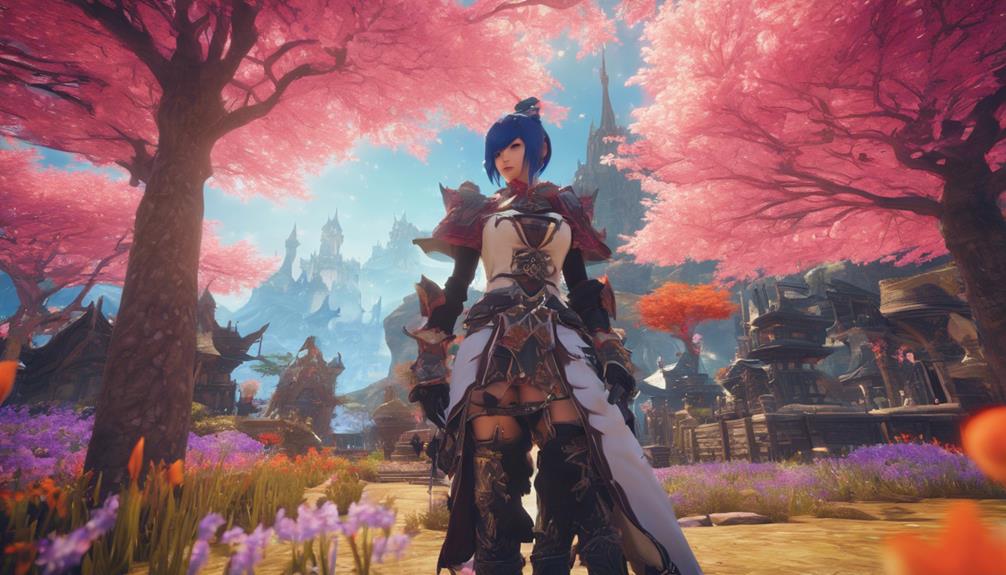Italian fashion combines elegance and innovation, with a foundation in a historic past that dates back to the Renaissance. You’ll discover iconic designs known for their exceptional tailoring, luxurious fabrics, and timeless accessories. Designers such as Armani and Prada have reshaped modern fashion while paying homage to tradition. Whether you prefer stylish blazers or sophisticated layered ensembles, Italian fashion highlights top-notch craftsmanship and meticulous attention to detail. Be sure to check out local boutiques or eco-friendly brands to elevate your wardrobe sustainably. If you’re interested in how film and culture influence these trends, there is much more to explore!
Key Takeaways
- Italian fashion originated during the Renaissance, establishing high standards in craftsmanship and leading to the renowned 'Made in Italy' label.
- Milan Fashion Week is a significant global event, showcasing innovative designs from iconic Italian designers like Giorgio Armani and Miuccia Prada.
- Key characteristics include exceptional tailoring, luxurious materials, and a blend of traditional techniques with contemporary elements.
- Sustainable practices are increasingly prominent, with many brands focusing on eco-friendly materials and circular fashion models.
Origin and historical background of the fashion trend/style
Italian fashion has transformed dramatically over the decades, starting from its rich Renaissance roots.
You'll see how the evolution of styles and the introduction of Milan Fashion Week have played essential roles in shaping trends.
Let's explore how these elements have contributed to the global influence of Italian fashion.
Fashion's Transformation Through Decades
Fashion's transformation through the decades showcases a rich history rooted in the Renaissance, where key cities like Venice and Florence established the foundation for today's styles.
Italian fashion brands emerged as pioneers in textile production, setting high standards for craftsmanship and design. The 'Made in Italy' label, which gained prominence in the 1950s, became synonymous with quality, helping elevate Italian fashion on the global stage.
The first Italian fashion show in 1951 marked a pivotal moment, bridging Haute Couture with practicality, thereby influencing future trends. Designers like Giorgio Armani and Miuccia Prada played significant roles in reshaping the landscape, merging traditional techniques with innovative designs.
As you explore Italian fashion, you'll notice the cyclical nature of trends, where past influences often resurface in contemporary collections. This interplay of history and modernity highlights how Italian fashion brands honor their roots while embracing change.
Understanding this evolution enriches your appreciation of the styles that continue to define Italy as a fashion capital. Fundamentally, the journey of Italian fashion reflects not just trends, but a legacy that continues to inspire and captivate.
Fashion Week Innovations
The evolution of fashion shows since the first Italian event in 1951 highlights a remarkable journey of innovation that continues to shape contemporary presentations. This pivotal moment bridged Haute Couture with American functionality, establishing Milan as a true fashion capital. As Milan Fashion Week grew in the 1950s, it became one of the 'Big Four' fashion weeks globally, showcasing the latest collections from renowned designers.
Fashion week innovations have transformed the way we experience fashion. Unconventional venues, like Fendi's runway on the Great Wall of China in 2007, illustrate the creative spirit that defines Italian shows, aiming to create unforgettable moments.
In 1994, Tom Ford's daring Gucci runway revitalized the brand with provocative designs, pushing the boundaries of bold statements and visibility.
Moreover, the iconic 2018 Versace Supermodel Reunion during Milan Fashion Week tapped into nostalgia, celebrating the legacy of 90s supermodels. This trend illustrates how past influences continually shape current styles and presentations.
As you explore these innovations, you'll see how they not only enhance the spectacle of fashion but also engage audiences in new and exciting ways.
Key Characteristics

When you explore Italian fashion, you'll quickly notice its signature tailoring techniques that set it apart.
The luxurious silk and rich leather used in garments not only elevate your wardrobe but also guarantee comfort and style.
Plus, timeless tailored blazers are a staple, blending classic elegance with modern flair to keep your look fresh.
Signature Tailoring Techniques
Italian tailoring showcases signature techniques that highlight impeccable craftsmanship and a commitment to quality.
You'll find that hand-sewn seams and exquisite embroidery are hallmarks of this exceptional art form. Each tailored garment is crafted from luxurious fabrics, ensuring that comfort meets elegance in every piece.
The focus on timeless silhouettes means that Italian tailors create clothing designed to last, transcending fleeting fashion trends. These classic styles resonate across generations, making them a staple in any wardrobe. Attention to detail is paramount; intricate embellishments and precise cuts further enhance the overall aesthetic of tailored clothing.
Another key characteristic of Italian tailoring is the integration of traditional techniques with contemporary elements. This innovative approach allows artisans to honor their rich heritage while keeping their designs fresh and relevant.
When you invest in a tailored piece, you're not just purchasing clothing; you're acquiring a work of art that embodies the essence of Italian craftsmanship.
Luxurious Silk and Rich Leather
Luxurious silk and rich leather define the essence of Italian fashion, offering an exquisite blend of sophistication and durability. When you think of Italian style, these materials come to mind, showcasing the country's commitment to quality and craftsmanship.
Silk, often sourced from Como, features vibrant colors and intricate patterns that elevate any wardrobe. You'll find that Italian designers expertly incorporate silk into their collections, creating pieces that are both elegant and functional.
On the other hand, rich leather, particularly from Florence, highlights the skill of Italian artisans. These craftsmen use traditional techniques to produce high-quality leather goods that stand the test of time. The 'Made in Italy' label isn't just a mark of authenticity; it signifies meticulous attention to detail and premium materials that define Italian luxury.
As sustainability becomes a priority, many brands are now focusing on eco-friendly practices in sourcing and production. This shift guarantees that while you indulge in luxurious silk and rich leather, you're also supporting a more responsible fashion industry.
Embracing these key characteristics of Italian style allows you to appreciate the perfect balance of elegance and durability in your wardrobe.
Timeless Tailored Blazers
Timeless tailored blazers embody impeccable craftsmanship and high-quality materials, making them a cornerstone of sophisticated wardrobes.
When you choose a blazer that's Made in Italy, you're investing in a piece that features hand-sewn seams and luxurious fabrics like wool or cashmere. These blazers showcase classic silhouettes with structured shoulders and fitted waists, providing versatility for both formal and casual occasions.
You'll notice that Italian blazers often incorporate intricate details, such as embroidered lapels, unique buttons, and practical vents. These elements not only enhance their aesthetic appeal but also contribute to their functionality, ensuring they remain a staple in your wardrobe.
A tailored blazer can effortlessly elevate your look; pair it with tailored trousers or a chic dress, and it seamlessly shifts from day to night.
The color palette of timeless tailored blazers ranges from classic neutrals like black, navy, and gray to bold prints and vibrant hues. This variety caters to your personal style while maintaining an air of elegance.
With a well-fitted blazer, you'll embody the sophistication that defines Italian fashion and elevate your wardrobe to new heights.
Modern Interpretation
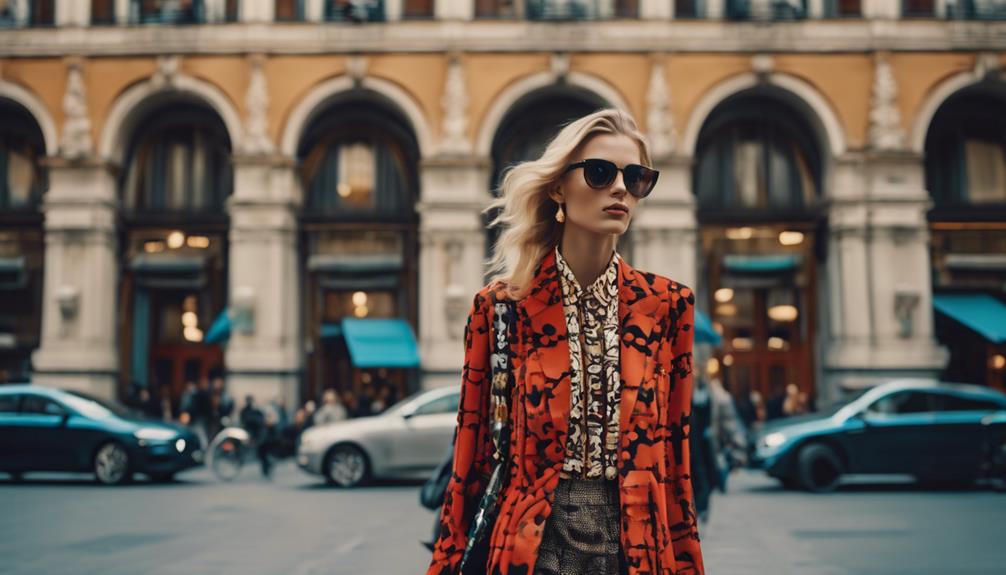
In today's fashion scene, you're likely to notice a strong emphasis on sustainable practices, with many Italian labels prioritizing eco-friendly materials.
Emerging designers are making waves, pushing boundaries while honoring Italy's rich fashion heritage.
Plus, icons from the 2000s continue to influence styles, reminding you of how past trends shape modern interpretations.
Sustainable Fashion Practices
Sustainable fashion practices are transforming the Italian fashion industry, as designers increasingly embrace eco-friendly methods and materials to meet consumer demand. With 66% of consumers preferring brands that prioritize sustainability, it's clear that the shift isn't just a trend but a necessity. Many Italian designers are adopting circular fashion models, focusing on recycling materials and minimizing waste throughout the production process.
Technological innovations are at the forefront of this movement, leading to the development of sustainable materials like biodegradable fabrics and recycled textiles. You'll find that collaborations between fashion houses and environmental organizations are becoming more common, which fosters the creation of eco-friendly collections that truly emphasize sustainable practices.
This growing emphasis on sustainability isn't just good for the planet; it also highlights the significant economic potential of integrating these practices. The Italian fashion market, valued at approximately €83 billion in 2020, shows that consumers are willing to invest in brands that align with their values.
As you explore the latest trends, you'll notice that sustainability is becoming an essential part of the fashion conversation, reshaping how you think about style and responsibility.
Emerging Italian Fashion Labels
Emerging Italian fashion labels are shaking up the scene with their bold designs and invigorating interpretations of luxury, blending urban aesthetics with high-quality craftsmanship.
Brands like GCDS and Fendi's new line redefine streetwear, showcasing daring prints and innovative styles that appeal to a younger demographic. You'll find that Forte Forte stands out with its bohemian flair and commitment to sustainability; their artisanal pieces resonate with modern consumers looking for timeless elegance.
Francesco Ragazzi's Palm Angels takes a unique approach by merging Californian skate culture with Italian craftsmanship, creating collections that exude a laid-back sophistication. This blend captures the essence of youthful rebellion while maintaining a luxurious edge.
Etro continues to innovate as well, incorporating their signature paisley prints with eco-friendly materials, reflecting the industry's growing focus on sustainable practices.
Ganni, a luxury brand gaining popularity in Italy, focuses on playful designs and versatile styles, catering to those who value both comfort and elegance.
With these emerging Italian fashion labels, you can expect a revitalizing shift in the fashion landscape, where bold creativity meets conscious consumerism, setting new trends for the years ahead.
Fashion Icons of the 2000s
The bold fashion choices of icons like Jennifer Lopez and Naomi Campbell defined the 2000s, blending glamour with a touch of rebellion that continues to inspire today's trends.
Jennifer's iconic green Versace dress at the 2000 Grammy Awards didn't just steal the spotlight; it created a viral moment that led to the birth of Google Images. Meanwhile, Italian designers like Tom Ford were revitalizing brands such as Gucci, pushing provocative designs that set the tone for the era.
Supermodels like Naomi Campbell and Claudia Schiffer became synonymous with high fashion, dominating runways and ad campaigns, showcasing the allure of Italian craftsmanship.
The decade also saw a shift in fashion's accessibility, where luxury brands seamlessly blended everyday wear with elegance. Designer bags emerged as status symbols, a trend that many celebrities embraced.
Dolce & Gabbana's modern interpretations, such as the 'Viva La Mamma' collection, reflected deeper cultural values, emphasizing family and femininity.
This fusion of high fashion with relatable themes continues to resonate today, reminding us of the enduring legacy of the 2000s and the profound impact of Italian designers on contemporary style.
Styling Tips
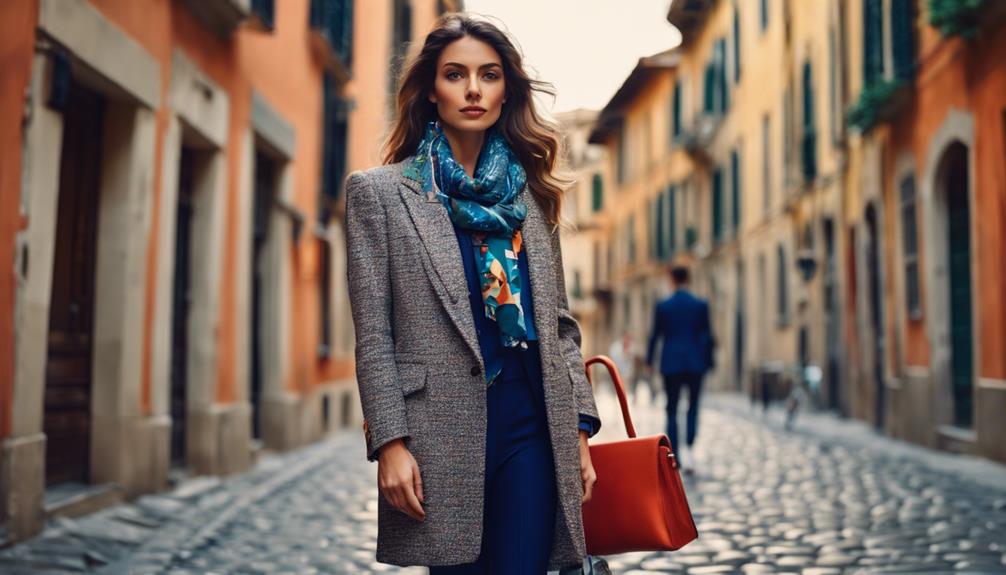
When it comes to Italian fashion, mastering classic tailored pieces is essential for creating a polished look.
You can elevate your style by layering textures and patterns, adding depth to your outfits while keeping them sophisticated.
Don't forget to play with elegant layering techniques to truly embody that effortless Italian chic.
Classic Italian Tailored Pieces
Investing in a well-fitted blazer can instantly elevate your wardrobe, making it a versatile piece for any occasion. Classic Italian tailored pieces, like blazers and tailored suits, prioritize impeccable craftsmanship, ensuring you look sharp and sophisticated. When choosing a blazer, opt for high-quality fabrics such as wool or silk, which embody the 'Made in Italy' standard.
Pair your blazer with tailored trousers featuring clean lines for a polished look. This combination allows for effortless styling, whether you're dressing up for a meeting or going out for dinner. Italian women often embrace this style by mixing tailored suits with casual knits, striking the perfect balance between chic and comfortable.
Don't forget the importance of accessories! Quality leather belts and shoes can elevate your outfit while adding a personal touch. Instead of following fleeting fashion trends, focus on classic pieces that promote sustainability and longevity in your wardrobe.
Elegant Layering Techniques
Mastering elegant layering techniques can transform your outfit, adding depth and sophistication to any look. As a young woman maneuvering through the fashion industry, you can easily elevate your style by choosing the right combinations.
Start with a tailored blazer over a flowing maxi dress. This combo is perfect for both casual outings and formal events, blending versatility with a polished appearance.
Another chic option is to wear oversized cardigans or long vests over fitted tops. This not only enhances your silhouette but also guarantees comfort without compromising elegance.
Don't forget the power of accessories; statement scarves and belts can truly elevate your layered looks, adding focal points and a personal touch.
Color coordination is key in achieving that sophisticated layer. Use neutral tones as your base and incorporate bold prints or vibrant hues for eye-catching contrasts.
Layering Textures and Patterns
Layering textures and patterns can effortlessly elevate your outfit, showcasing your personal style and creativity while embracing the essence of Italian fashion.
Start by combining luxurious materials like silk and cashmere; this not only adds depth but also highlights the quality that Italian fashion is known for. Don't shy away from mixing patterns—pairing stripes with florals is a bold move that reflects your individuality.
To tie your look together, accessories play a significant role. Incorporate statement belts or scarves to enhance your outfit while maintaining cohesion among the different textures and patterns.
Italian fashion often masterfully blends classic silhouettes with contemporary prints, striking a balance between timeless elegance and modern flair.
Shopping Guide
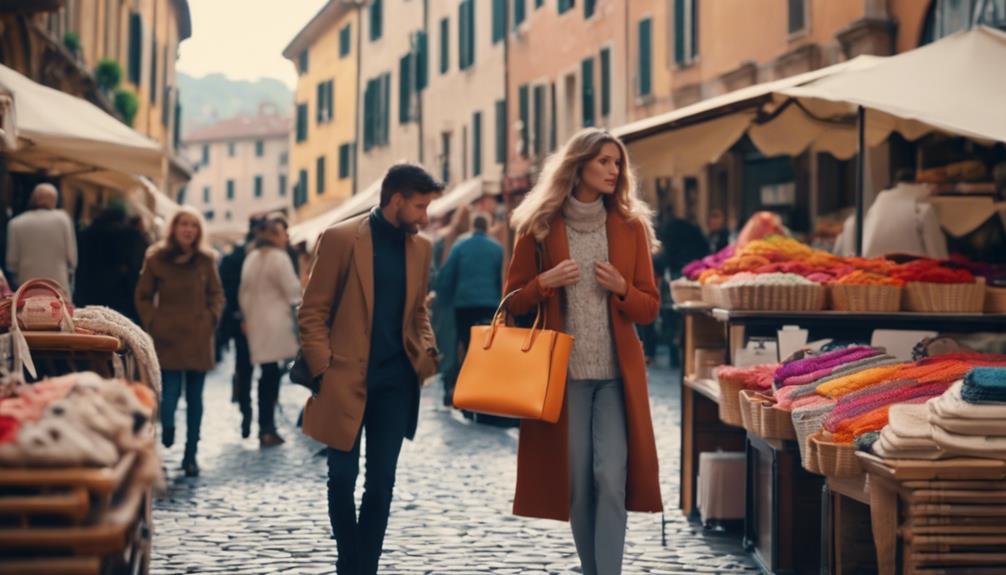
When you explore Italy's fashion scene, a visit to Milan's iconic shopping districts is a must for finding both luxury and unique pieces.
Start your journey at Via Montenapoleone, where you'll find high-end boutiques and luxury brands that define Italian fashion. Don't miss the Galleria Vittorio Emanuele II, a stunning arcade filled with designer stores and a quintessential Italian shopping experience.
For a more authentic touch, venture into the neighborhoods of Brera and Navigli. Here, you'll discover local artisans and boutiques offering handcrafted items that reflect the true essence of Italian craftsmanship. Keep an eye out for the 'Made in Italy' label, which signifies exceptional quality and is a hallmark of timeless style.
If you're on a budget, look for seasonal sales and outlet stores from renowned brands like Gucci and Prada. These spots often feature high-quality items at reduced prices, making it easier to invest in your wardrobe without breaking the bank.
This shopping guide to Milan will guarantee you find the perfect blend of luxury and uniqueness that Italian fashion has to offer. Happy shopping!
Upcycling Vintage Italian Garments
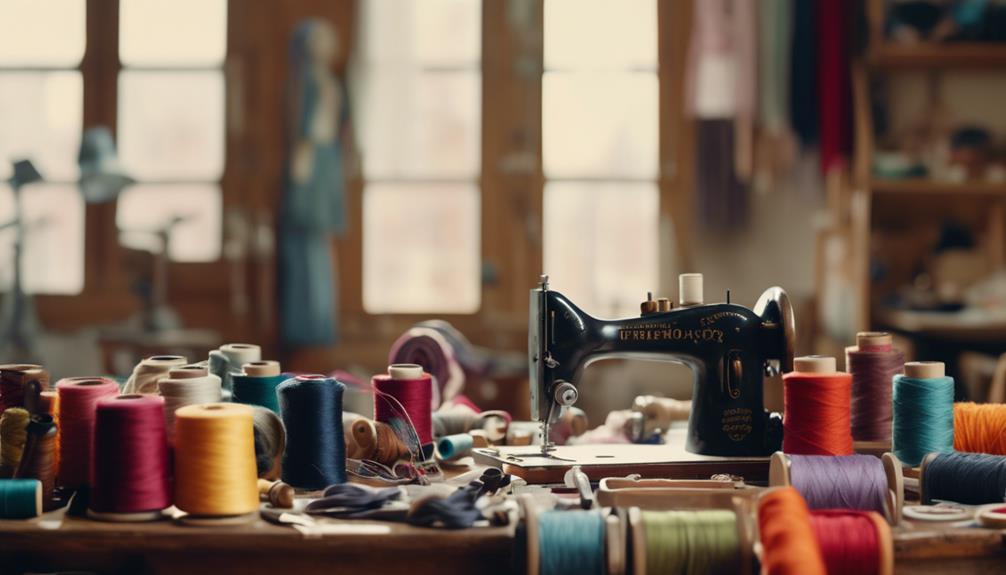
When you explore upcycled vintage Italian garments, you tap into a world of creativity and sustainability.
You can transform unique finds into personalized pieces that tell a story and reflect your style.
Plus, supporting this movement helps combat fast fashion and celebrates the rich heritage of Italian design.
Upcycled Vintage Fashion Projects
Upcycling vintage Italian garments not only breathes new life into pre-owned clothing but also champions sustainability in the fashion industry. By creatively transforming these unique pieces, you can embrace both style and eco-consciousness.
When you engage in upcycling, you're highlighting the exquisite craftsmanship and iconic designs of renowned Italian brands, ensuring that their heritage continues to resonate with new generations.
Whether you're a designer or a DIY enthusiast, you can incorporate modern styles and techniques into classic vintage cuts. This revitalization not only enhances the garments for contemporary wear but also allows for a tailored fit that reflects your personal style.
Additionally, upcycled pieces minimize waste, promoting a more responsible approach to fashion consumption. This trend supports the circular economy, where valuable resources are reused, greatly reducing textile waste and environmental impact.
As you commence your upcycled vintage fashion projects, remember that each transformation contributes to a more sustainable fashion landscape. By choosing to upcycle vintage Italian garments, you're not just making a fashion statement; you're also making a positive impact on the planet.
Personalizing Vintage Italian Finds
Personalizing vintage Italian finds lets you infuse your unique style into timeless pieces while celebrating their rich history and craftsmanship. Upcycling vintage Italian garments is a fantastic way to transform unique pieces into modern styles, emphasizing both sustainability and creativity in your fashion choices.
Italian vintage finds often feature luxurious fabrics like silk and cashmere, which can be repurposed into contemporary garments while retaining their original quality. You can alter silhouettes to fit your personal aesthetic, add embellishments for a touch of flair, or integrate modern accessories to create a fresh look that stands out.
The practice of upcycling aligns perfectly with the growing demand for sustainable fashion, as 66% of consumers prefer brands that prioritize eco-friendly methods. By embracing vintage Italian fashion, you not only celebrate the craftsmanship of iconic designers but also contribute to a circular fashion economy, helping to reduce waste in the industry.
Cultural Impact
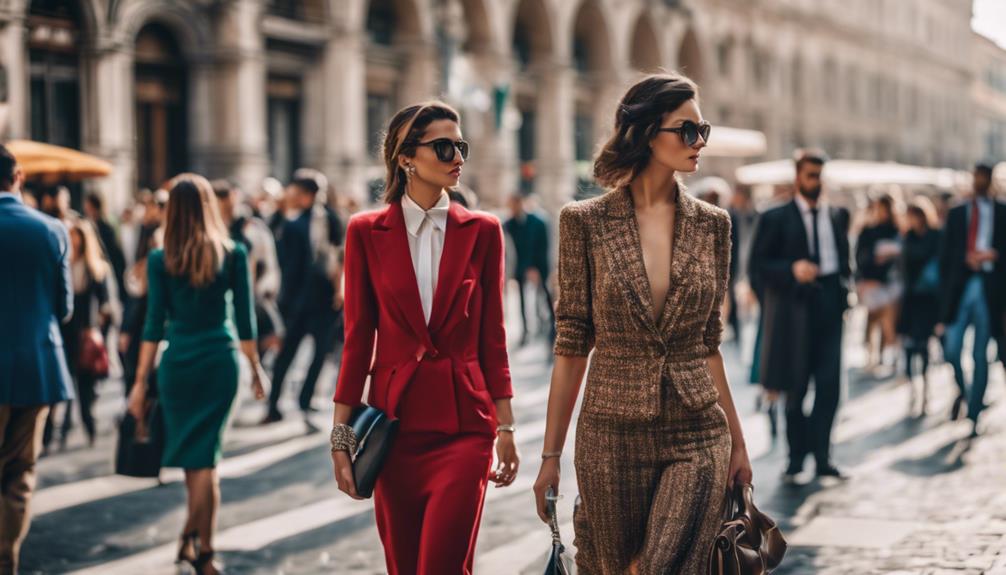
Italian films have a powerful way of shaping fashion trends, blending cinematic storytelling with style.
You'll see how iconic movies have influenced not just what people wear, but also how they express themselves.
Plus, the intersection of fashion and feminism in Italy adds another layer, showcasing how clothing can empower and redefine identities.
Italian Films Influencing Fashion Trends
Influencing global fashion trends, Italian films have a rich history of showcasing styles that resonate deeply with audiences. From the elegant attire of Audrey Hepburn in *Roman Holiday* to the chic ensembles in *La Dolce Vita*, these films have carved a noteworthy niche in fashion history. The iconic fountain scene in *La Dolce Vita* established a romantic image of Rome, prompting viewers worldwide to embrace Italian style.
Collaborations between filmmakers and designers often lead to unforgettable fashion moments, blending character storytelling with striking aesthetics. In the 1990s, *The Talented Mr. Ripley* showcased tailored suits and luxurious Italian brands, considerably impacting men's fashion trends. This blend of cinematic flair and design innovation continues to inspire both fashion enthusiasts and designers alike.
Moreover, Italian cinema often reflects cultural values, using clothing to convey character identities and societal themes. This connection between storytelling and fashion reinforces the idea that what we wear can express deeper narratives.
Fashion and Feminism in Italy
Fashion in Italy has become a powerful vehicle for feminist expression, showcasing how style can challenge norms and empower women. Designers like Miuccia Prada have taken bold steps to incorporate themes of female strength in their collections, redefining what it means to be a woman in fashion. By presenting designs that celebrate individuality and confidence, Prada and other influential designers are inspiring women to embrace their identities.
The rise of female designers has greatly challenged traditional gender roles within the fashion industry, paving the way for more women to assume creative leadership roles. Italian fashion shows increasingly highlight diverse body types and ages, promoting inclusivity and representation. This shift aligns with the broader societal movement towards gender equality, as fashion brands engage in social activism to address women's rights.
As you explore Italian chic, you'll notice that it encourages women to reclaim their agency and express themselves through fashion. This cultural impact not only reshapes the narrative around women's fashion but also resonates deeply with contemporary feminist movements, making Italian fashion a true reflection of empowerment and progress.
Frequently Asked Questions
What Is the Fashion Capital in Italian?
The fashion capital in Italian is "capitale della moda." You'll find Milan at the heart of this vibrant scene, showcasing incredible designs and hosting major fashion events that define global trends and styles every year.
What Is the Famous Fashion in Italy?
When you think of famous fashion in Italy, you can't ignore brands like Gucci and Prada. Their luxurious designs and craftsmanship set trends globally, making Italian fashion synonymous with elegance, quality, and timeless style.
Why Italy Is Called Fashion Capital?
Italy's called the fashion capital because you'll find rich design history, luxury brands, and influential fashion weeks. The commitment to quality craftsmanship and trendsetting cities like Milan solidify its prestigious status in the global fashion industry.
What Are the Big Four Fashion Capitals?
The big four fashion capitals are Paris, Milan, New York, and London. Each city showcases unique styles and trends, influencing global fashion and providing platforms for both emerging and established designers to shine.
What Influence Does the LA Fashion District Have on Italian Fashion Trends?
The LA Fashion District exerts a significant influence on Italian fashion trends. As the heart of trendsetting styles, the district’s edgy and urban designs often inspire Italian designers. The infusion of streetwear and casual chic from Los Angeles adds a fresh and modern twist to traditional Italian fashion.
What Are Some Iconic Italian Fashion Styles Showcased at Milan Fashion Week 2024?
The milan fashion week highlights 2024 are all about iconic Italian fashion styles. From luxurious fabrics to impeccable tailoring, the runway is filled with timeless elegance. The mix of modern designs and classic silhouettes showcases the versatility of Italian fashion, making it a must-see event for fashion enthusiasts worldwide.
Conclusion
To sum up, embracing Italian fashion means celebrating a rich history and iconic styles that continue to inspire today.
By understanding its key characteristics and modern interpretations, you can effortlessly incorporate these timeless pieces into your wardrobe.
Remember to explore vintage options for unique finds, and don't shy away from upcycling to give them new life.
With these tips, you'll not only look fabulous but also appreciate the cultural impact that Italian fashion has on the world.

